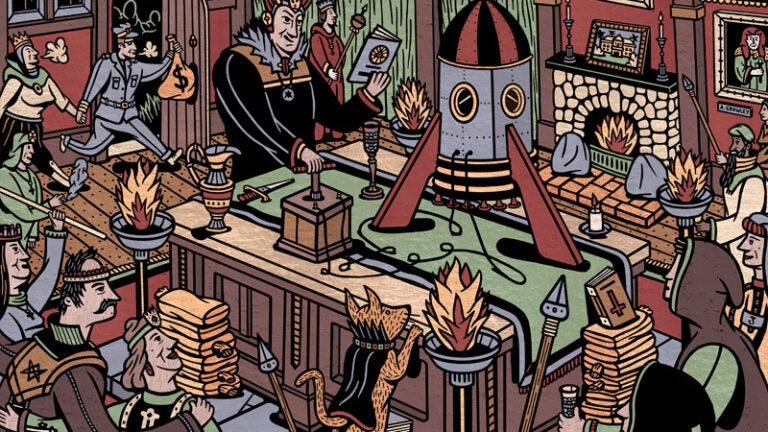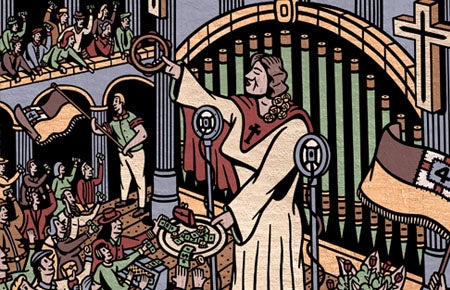
Worshipping on the Fringe
He was the original rocket man.
As a member of a group of daredevil Caltech scientists aptly known as the Suicide Squad in the 1930s and ’40s, John Whiteside Parsons helped usher in the Space Age with his combustible rocket fuel formulations.
Along the way, Parsons, who studied chemistry at USC Dornsife but never earned a degree, co-founded not only one of the first rocket companies but the prestigious Jet Propulsion Laboratory in Pasadena. Every space shuttle was thrust into orbit by fuel that was derived from his work.
Charming, brilliant and always nattily dressed, he was widely considered one of the most important figures of the U.S. space program.
He was also widely considered a colossal kook.
By day he worked shoulder-to-shoulder with preeminent scientists and government officials. By night, from his sprawling mansion on Orange Grove Avenue in Pasadena, Parsons indulged his passion for the occult. Indeed, he considered his experiments in black magic, not rocketry, to be his greatest contribution to humanity.
Frocked in a long black robe and with Prokofiev’s Second Violin Concerto providing the melodramatic soundtrack, Parsons would stand before a pentagram and an altar in his bedroom as he tried to conjure up spirits and, in one case, a new girlfriend.
The mansion, with its 11 bedrooms and secret passageways, was not only the home of Parsons but an improbable mix of occultists and scientists. Monogamy was brushed off as impossibly bourgeois, leading to rampant partner swapping that made for a Rubik’s Cube of carnal combinations. Twenty-five acres of land afforded plenty of room to raise animals, which came in handy when their blood was needed to make wafers for religious ceremonies.
But the good times didn’t last.
Parsons’ fortunes began to ebb after a young, charismatic science fiction writer took up residence and proceeded to make off with his girlfriend and most of his savings, according to the Parsons biography Strange Angel by George Pendle. The science fiction writer, L. Ron Hubbard, went on to found the Church of Scientology.
Parsons died in 1952 at the age of 37, when his home laboratory exploded. Police ruled it an accident, but theories of foul play abounded, including the idea that Howard Hughes had ordered his murder in retribution for Parsons having taken documents from the eccentric industrialist.
Welcome to the City of Angels — and other mystical phenomena.
Beginning in the mid-19th century and careening into the present, L.A. has been a magnet for alternative spiritual movements. From harmless sects to murderous cults, these movements have helped define the city as the land of rebirth, new ideas, reinvention and, sometimes, the plain old whacky.
“[L.A.] draws people who are seekers,” said Professor of History William Deverell. “They feel themselves at the edge of the world so why not look for another edge between this life and the next?”

Some of L.A.’s most successful religious figures have been as good at larding their savings accounts as saving souls.
Religious rundown
So much of what we know about alternative religions has been conveyed through the media’s coverage of the most outlandish examples. L.A. denizen Charles Manson and his band of malevolent misfits still generate headlines. So does preacher-turned-mass murderer Jim Jones, whose Peoples Temple church was located blocks from USC at the corner of Alvarado and Hoover streets.
“Ever since mainstream media became beholden to a mass audience, which was when the penny press began in the 1830s, it needed to appeal to the lowest common denominator, and the publishers quickly realized that meant sensationalism and conflict and scandal,” said
Diane Winston, Knight Chair in Media and Religion at USC Annenberg School for Communication and Journalism and a former religion reporter.
But the vast majority of alternative religions are distinguished only by the fact that they are not part of the Abrahamic tradition. What most share is mockery, derision and disregard from the mainstream.
“Every religious minority community has had a challenge of assimilating into a country that was founded on religious freedom,” said Varun Soni, dean of religious life at USC.
Although L.A. remains a hotbed of alternative religions, the golden age of new spiritual movements unfolded in the 1920s and ’30s. Predictably, it drew howls of ridicule from the media and various pundits.
As Britain’s Aleister Crowley put it in about 1915, L.A. is home to “the cinema crowd of cocaine-crazed, sexual lunatics, and swarming maggots of near-occultists.” Never mind that this description fit Crowley to a T — and that his work in black “magick” had inspired Parsons.
Or, as Los Angeles Times columnist John Steven McGroarty wrote in 1921: “[L.A.] is a breeding place and a rendezvous of freak religions. But this is because its winters are mild, thus luring the pale people of thought to its sunny gates.”
Mind you, in those days, “freak religions” included practices that are now widely endorsed by health professionals, including yoga and health food. They also included now well-accepted religions such as Hinduism, Mormonism and Self Realization.
In the seminal book Southern California, An Island on the Land, published in 1946, author and USC Gould School of Law alumnus Carey McWilliams ’27 described the town of Ojai as “a section of Southern California thoroughly impregnated with occult and psychic influence,”
in part because it was the adopted home of religious philosopher Krishnamurti, whose foundation carries on and is hardly considered a home for the dark arts. (For the record, I grew up in Ojai a short walk from Krisnamurti’s home. I never once heard him utter incantations. He did, however, speak at my high school.)
The point is that the animus directed toward various alternative religious movements often wanes over time — as long as the movements are not too extreme. “Today’s cult is tomorrow’s religion,” Soni said.
Reaching for souls and wallets
Many of the alternative religions that took root in L.A. were founded by charismatic individuals who were as interested in fattening their savings as saving souls.
Aimee Semple McPherson arrived in L.A. in 1922 with $100 and two kids. Within three years, she was a millionaire. At her Angelus Temple overlooking Echo Park Lake, she attracted thousands of followers from all walks of life, rich and poor, black and white. With seating for 5,300, the temple was America’s first megachurch.
Like many successful preachers, she was a master showman. “She was cinematically gifted,” Deverell observed.
As with so many religious leaders who claim to eschew worldly temptations, McPherson’s downfall arrived when it was discovered that she had faked her own kidnapping, during which she had engaged in a tryst with a former Temple employee.
One of the most successful and enduring religious movements to originate in L.A. was I AM. Like many others, it was started by transplants from the East Coast — in this case Guy and Edna Ballard — who saw or heard visions.
Guy Ballard claimed to have his encounter with the divine when the famed alchemist Comte St. Germain offered him a cup of “pure electronic essence” during a hike on Mt. Shasta. Apparently avoiding electrocution, Ballard said he and St. Germain then embarked on a trip around the world through the stratosphere visiting, among other places, Yellowstone National Park.
Ballard chronicled his travels in a 1934 book titled Unveiled Mysteries, which established the foundation for a thriving
enterprise of additional books, photos, records and New Age cold cream, among other enlightening — and enriching — curios. According to McWilliams’ book, an audit of I AM showed that it amassed $3 million in sales, contributions and “love offerings.” The organization remains active.
So does Maria Paula Acuña.
Vision quest
For more than 20 years, hundreds, even thousands, of people have followed Acuña every month to a parched stretch of the Mojave Desert, 100 miles north of L.A., where she claims to see the Virgin Mary.
“People take photos of the sun and then decode them for messages from God and the Virgin,” said Lisa Bitel, Dean’s Professor of Religion and professor of religion and history, who wrote a book about Acuña titled Our Lady of the Rock (Cornell University Press, 2015).
“The group I studied out in the desert called themselves Catholics, but they were far more charismatic, and of course they were following a particular woman who sees the Virgin Mary and skips priests and church to give them the theology and doctrine they want,” Bitel said. “They were negotiating with Catholicism.”
The abundance of alternative religions in L.A. is one of the reasons so many people from the rest of the country view the state with deep suspicion. But for those who thrive on diversity, free thinking and the eccentric, L.A.’s religions — from the staid to the loopy — are part of the multicolored fabric that gives this city its vibrancy.
“I see a ferment, a petri dish of religions,” Bitel said. “Who knows what’s going to come of it. It’s been that way for a century. Isn’t it cool?”
Read more stories from USC Dornsife Magazine’s Fall 2018/Winter 2019 issue >>